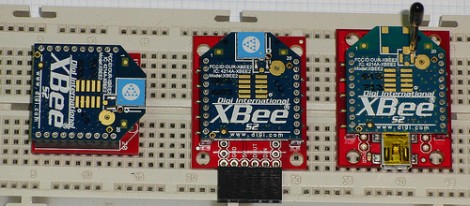
Here’s a bulky tutorial that will round-out your understanding of ZigBee wireless communications (translated). The protocol is great for hobby electronics projects because it uses low-power short range wireless devices to build a mesh network. The guide covers both hardware and software, but also takes the time to explain what that hardware is doing in the background.
As you can see, several different renditions of an XBee module are used as examples. They pretty much all rely on a series of SparkFun breakout boards that each serve different purposes. Once you’ve acquired these modules, there’s a fair number of choices needed to configure them to play nicely with each other. We read most of the tutorial (we’ll save the rest for later enjoyment) and had no problem following along even without owning the hardware or being able to use the interface as we learned.
Whenever we cover XBee modules we always like to mention that it’s quite easy to use these for remote sensors with no additional microcontroller needed.
















Its it Spanish?? Wtf?
At first I was all excited to read about the ZigBee. Damn you hackaday for wetting my appetite and then linking to a Spanish Blog. I even tried to Bablefish the link but to hard to understand :(
The XBees pictured above are not ZigBee-compatible. XBee and ZigBee are both software stacks/protocols that implement additional functionality on top of the IEEE 802.15.4 wireless standard for low-power wireless communication. They are not directly compatible with one-another (if at all). However, Digi does make the XBee ZB which is ZigBee-compatible but it is not compatible with the regular XBee/XBee PROs used by most hobbyists.
http://www.digi.com/products/wireless-wired-embedded-solutions/zigbee-rf-modules/zigbee-mesh-module/xbee-zb-module
From the translated site:
“To begin with I have decided on ZigBee modules will buy Digi: XBee Series 2 , do not confuse with the Series 1 802.15.4 modules which are but do not implement ZigBee networks and allow you to mount multiple devices.”
I spoke too soon. The Zigbee-compatible modules are being used in this.
I love ZigBees, but those .1 pinout boards are way more expensive than they need to be.
I got a few Sena Zigbee Boards to play with the Ember EM357 chipset as some xbees where on backorder.
Hi, I am trying to unlock the EM357 and gain debug access without an IAS3.
It this feasable or am I wasting my time ?
I like 6LoWPAN more
http://en.qi-hardware.com/wiki/Ben_WPAN
Cheap for hobbyists that have no f@cking clue what they’re doing. Or cheaper than full blown ZigBee. Also very user friendly. Seems like there’s a pretty good following. It’s a shame that no one has reverse-engineered the xBee’s to a breadboard. I suppose digikey wouldn’t like that a whole lot.
This is an incredibly expensive approach for most – that can do the same thing with an ~ISM radio.
I suspect that most beginner development does not need the power or range.
There are cheaper options, if you’re not trying to be an EE or CE, such as:
https://estore.ti.com/430BOOST-CC110L-CC110L-RF-Module-BoosterPack-P2734.aspx
I want to echo Hackaday’s note that these devices can be used to transmit useful information without a microcontroller, if you know how to configure it correctly. I just did a remote control robot platform project where the remote is an XBee with joystick and buttons connected, but no MCU:
http://nootropicdesign.com/projectlab/2012/02/18/xbee-robotics-platform/
1. Is any of these modules compatible with the ZLL (zigbee light link)?
2. Are series 1 and 2 completely incompatible?